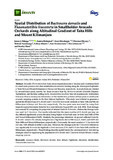| dc.description.abstract | Avocado (Persea americana) fruits are an important source of income and a nutritious food for small-scale growers and other stakeholders involved in farming along the Afrotropical highlands of Taita Hills and Mount Kilimanjaro in Kenya and Tanzania, respectively. Avocado fruits are infested by several insect pests, namely the Asian invasive fruit fly, Bactrocera dorsalis (Hendel) (Diptera: Tephritidae), and the false codling moth, Thaumatotibia leucotreta Meyrick (Lepidoptera: Tortricidae). However, there is inadequate information on the distribution patterns of these pests in small-scale avocado cropping systems in the East African highlands. This study was initiated to generate a spatial distribution map of B. dorsalis and T. leucotreta in avocado orchards at Taita Hills and Mount Kilimanjaro in Kenya and Tanzania, respectively. The two pests were monitored by using their respective parapheromone lures for two years between August 2012 and July 2014. Fruit damage was assessed by computing the proportion of infested fruits for B. dorsalis, whereas the damage score was used for T. leucotreta. Our results indicated that the mean number of B. dorsalis per trap per day differed significantly across elevation, being highest in lowland zone for both Taita Hills (15.90) and Mount Kilimanjaro (24.45). Similarly, the percentage infestation of ground collected fruits by B. dorsalis varied with altitude, being lowest at highlands above 1500 m.a.s.l. (0.66% and 0.83% for Taita Hills and Mount Kilimanjaro, respectively). Conversely, the mean number of T. leucotreta did not vary with altitude in either study area. However, the damage score for T. leucotreta infestation was significantly lower in the highlands of both transects (7.0% and11.1% for Taita Hills and Mount Kilimanjaro, respectively). These findings describe spatial trends that are important in formulating strategies aimed at suppressing the populations of B. dorsalis and T. leucotreta in East African avocado cropping systems. | en_US |



